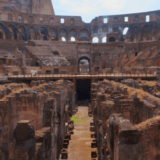Who built the Colosseum?

The Colosseum, a timeless marvel of architectural brilliance, stands as a testament to the grandeur of ancient Rome. This colossal amphitheater, located in the heart of Rome, has captivated the world with its sheer scale and engineering marvels. But who were the masterminds behind this iconic structure? In this article, we will delve into the rich history of the Colosseum and uncover the names of the architects who brought this magnificent amphitheater to life, so let’s answer the question, who built the Colosseum?
Table of Contents
ToggleVespasian and the Birth of the Colosseum

The construction of the Colosseum began during the reign of Emperor Vespasian in 72 AD. Vespasian sought to consolidate his power and gain the favor of the Roman people. He envisioned a grand amphitheater that would surpass any other in size and splendor. To bring his vision to reality, Vespasian enlisted the expertise of skilled architects and engineers.
Architectural Masterminds: The Flavian Dynasty
The Flavian Dynasty played a crucial role in the design and construction of the Colosseum. Vespasian’s son, Titus, who succeeded him as emperor, took over the project and ensured its completion in 80 AD. The primary architects responsible for the Colosseum were believed to be Celer and Severus, both renowned for their architectural prowess.
Celer, a skilled engineer, contributed to the structural design of the amphitheater, focusing on its massive scale and innovative building techniques. His expertise in using concrete and arches played a pivotal role in constructing the awe-inspiring structure we see today. Severus, on the other hand, focused on the intricate details, including the magnificent façade, the seating arrangements, and the complex system of tunnels and chambers beneath the arena.
Collaboration and Innovation
The architects of the Colosseum embraced innovation and collaborated with a team of skilled artisans, engineers, and laborers. This collaboration allowed them to incorporate groundbreaking features into the amphitheater’s design. The ingenious use of concrete, which revolutionized construction techniques, enabled the architects to create a massive structure that could accommodate over 50,000 spectators.
The elliptical shape of the Colosseum, with its system of arches and vaults, provided structural stability while distributing the weight of the structure evenly. This architectural ingenuity allowed the Colosseum to withstand the test of time, surviving earthquakes, fires, and centuries of neglect.
A Symbol of Roman Entertainment

The Colosseum was primarily built as a venue for various spectacles, including gladiatorial contests, animal hunts, and theatrical performances. The architects had to consider the intricate mechanisms required to stage these events. They designed a complex system of tunnels, chambers, and lifts that allowed for the efficient movement of performers, animals, and props, creating a seamless and awe-inspiring experience for the spectators.
Conclusion
The Colosseum stands today as a magnificent testament to the architectural brilliance of ancient Rome. The architects of the Flavian Dynasty, Celer and Severus, along with their team of skilled craftsmen and laborers, left an indelible mark on history. Their vision and innovation brought to life an amphitheater that continues to captivate the world with its grandeur. The Colosseum not only served as a symbol of Roman entertainment but also showcases the remarkable engineering achievements of the ancient world.
Ready to embark on an extraordinary journey through history at the Colosseum? Secure your ticket now and unlock the secrets of ancient Rome’s most iconic landmark. Immerse yourself in the grandeur of the amphitheater, where gladiators once battled for glory. Don’t miss this chance to walk in their footsteps and witness the awe-inspiring architecture firsthand. Click here to book your ticket and ensure an unforgettable experience at the Colosseum. Join us and create memories that will last a lifetime.
 Spanish
Spanish
